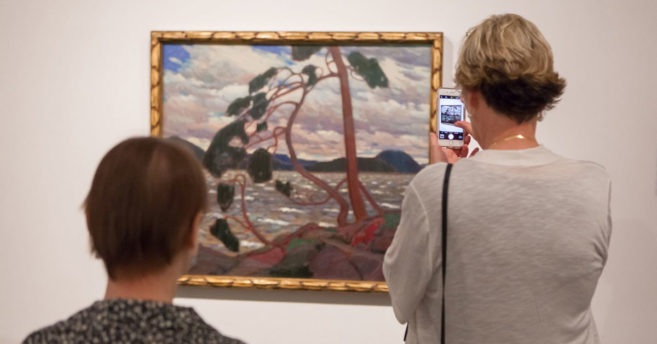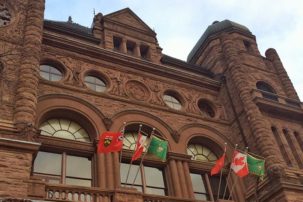NOTE: This story was prepared prior to the outbreak of COVID-19. Some information may have since changed.
Even prior to the outbreak of COVID-19 in Ontario, recent months have seen multiple regional arts organizations facing funding and space challenges.
In late January, Norfolk County council suddenly closed the Norfolk Arts Centre, Norfolk County Archives, the Teeterville Museum and the Teeterville Women’s Institute, following budget pressures on the municipality. Norfolk Arts Centre curator Roberta Grosland was also dismissed at that time.
The decision to close came just days after the Norfolk Arts Centre opened its latest exhibitions, including a solo show by artist Patricia Deadman, who also works as curator at the Woodland Cultural Centre in Brantford. She says she is concerned about how the closure unfolded and what the implications for arts accessibility in the local community might be. The collection of the Norfolk Arts Centre consists of some 900 works, including pieces by Jack Bush, Carl Beam, Greg Curnoe and others.
Zainub Verjee, executive director of the Ontario Association of Art Galleries (OAAG), says she is concerned that Norfolk County has not given enough consideration to these collections. Closing any museum is a “complex activit[y] that require[s] strategic planning,” Verjee says, quoting from a letter that the OAAG wrote to the Norfolk County mayor on February 12: “We do not believe [that planning] has been conducted.”
Verjee says the OAAG recently met with local community members who have started a “Save Our Stories” campaign. “Community members have many unanswered questions,” Verjee said via email, adding that “there has been the classic temptation of deaccessioning [as a way] to plug budgetary holes.”
“I think history has proven that societies that turn their back on culture live to regret it”
Norfolk County officials say that the arts centre was taken under its wing in 2003, and prior to that it had been community-operated for some decades as Lynwood Arts Centre. In recent weeks, County officials say they’ve begun discussions about transferring the arts centre back to a community group.
“The [2003] transfer agreement between the Lynnwood group and Norfolk County states that should Norfolk County cease to operate an arts centre, the building and collection would be offered back to the Lynnwood group,” says Matt Terry, director of corporate communications for Norfolk County. “If a community organization such as the Lynnwood Board of Management is unable to take over operations, the entire collection including the recent donation will be relocated to the Eva Brook Donly Museum which currently houses the Norfolk County Archives.”
Terry adds: “Norfolk County will continue to be excellent stewards of this public art collection as long as it remains under its [the County’s] ownership.”
*
Other municipally funded arts organizations in Ontario are having similar concerns, particularly around financial support.
On January 22 and February 12, the Richmond Hill City Council voted to disapprove all grants planned through its Community and Cultural funding program for 2020. Among the projects that went unfunded as a result were the High Notes Avante Choir for people with mental illness; a Richmond Hill Philharmonic Orchestra concert; and a festival around art and migration.
“I don’t think that the residents of Richmond Hill want us taking their tax dollars and handing it out to community groups,” said Councillor Greg Beros, who moved to not approve the funding. “They can very well make donations themselves and receive the benefit of a tax receipt.”
Councillor Castro Liu, who voted to keep the funding program, said, “I think all these organizations are valuable to our community and they are serving those we cannot directly serve.” Liu also objected to the funding process being discarded so late in the 2019–20 funding cycle.
Richmond Hill communications advisor Lynn Chan tells Canadian Art that the City continues other kinds of arts program such as “the Art & Studio Tour, Visual Art Gallery at the Richmond Hill Centre for the Performing Arts and at various community events throughout the year,” as well as an annual cultural summit slated for March 31 that includes awards and an artist residency announcement.
Nevertheless, the one local culture-community representative who was able to speak before council, Mary-Lou Montgrain of Chorus York, had this to say about the community and culture grant cuts: “I think history has proven that societies that turn their back on culture live to regret it.”
*
On February 19 in Toronto, representatives of the Toronto Media Arts Centre (TMAC) and the City of Toronto underwent a legal cross-examination about their differing perspectives on an ongoing conflict: TMAC was originally promised its space, located on the ground floor of a condo building, under Toronto bylaw Section 37 (whereby developers may increase height and density in exchange for providing community benefits)—but TMAC says it’s now being denied title to the space.
“The City says it’s supporting arts and culture on one hand and on the other doing very little to support the groups with needs who actually do that arts and culture work,” says Henry Faber, board chair of TMAC.
Faber also claims the City has changed its criteria for achieving title as the process has unfolded, resulting in a situation where TMAC had to give back $300,000 in federal funding after process delays.
“We have generated more than 200 letters of support from community organizations, artists, neighbours and constituency groups,” Faber says. “Since we opened, 60,000 people have visited the space.”
For its part, City of Toronto representatives say that part of the issue are the financial problems of a condo developer who built the tower that houses TMAC.
“Municipalities are making cuts to arts and culture probably because they are easy targets—especially due to the larger municipal service funding cuts from the province,” says one expert in the field.
“The City does not have legal title to the arts and culture space at this time,” says Pat Tobin, the director of arts and culture services at the City of Toronto. “The space is currently still owned by the developer who built it, Edge on Triangle Park, which is undergoing insolvency proceedings.”
The City of Toronto also says it is concerned about TMAC’s ability to meet financial obligations. “The City has thoroughly reviewed the financial documentation provided by TMAC, and the City’s position is that TMAC has failed to meet the terms of the fundraising targets contained in the Minutes of Settlement that TMAC had agreed to,” says Tobin.
A meeting in front of an Ontario Superior Court judge was slated for April 15.
*
In St. Catharines, the Rodman Hall Art Centre, which has operated for more than five decades, remains in limbo. In December 2019, Brock University and the Rodman Hall Art Centre Inc. (RHAC Inc.) issued a formal request for expressions of interest “to identify parties who have the interest and ability to help transform the historic property into an economically viable and culturally sustainable operation.”
In an April 2019 press release about the need to divest itself of Rodman Hall before a 2023 deadline, Brock University referred to decisions by the provincial government: “The Ontario government’s recent 10 per cent tuition cut leaves Brock with a $15.4-million budget shortfall, which officials are working to mitigate before the fiscal year starts on May 1.”
Although the City of St. Catharines formed a Rodman Hall Task Force to address issues with the institution and its role in the local arts scene, the City has made no motion to purchase the building itself.
While all these incidents—the situations at Norfolk, TMAC, Richmond Hill and Rodman Hall—are different, Verjee noted that they do all come after the Ontario provincial government has put further pressures on municipalities.
“We have to be very careful as to what is happening with the municipal service deliveries and their relationship with the province,” says Verjee.
“It is evident that municipalities are making cuts to arts and culture probably because they are easy targets especially due to the larger municipal service funding cuts from the province,” Verjee says. “Municipalities in 2020 are now left to co-pay [more] for public health care. Ontario municipal budgets are tighter and so, as a result, arts and cultural services are taking a hit.”








